Idil Ozdamar
Human-Robot Interfaces and Interaction, Istituto Italiano di Tecnologia, Genoa, Italy, Dept. of Informatics, Bioengineering, Robotics, and System Engineering, University of Genoa, Genoa, Italy
Context-aware collaborative pushing of heavy objects using skeleton-based intention prediction
May 15, 2025Abstract:In physical human-robot interaction, force feedback has been the most common sensing modality to convey the human intention to the robot. It is widely used in admittance control to allow the human to direct the robot. However, it cannot be used in scenarios where direct force feedback is not available since manipulated objects are not always equipped with a force sensor. In this work, we study one such scenario: the collaborative pushing and pulling of heavy objects on frictional surfaces, a prevalent task in industrial settings. When humans do it, they communicate through verbal and non-verbal cues, where body poses, and movements often convey more than words. We propose a novel context-aware approach using Directed Graph Neural Networks to analyze spatio-temporal human posture data to predict human motion intention for non-verbal collaborative physical manipulation. Our experiments demonstrate that robot assistance significantly reduces human effort and improves task efficiency. The results indicate that incorporating posture-based context recognition, either together with or as an alternative to force sensing, enhances robot decision-making and control efficiency.
A Machine Learning Approach to Sensor Substitution for Non-Prehensile Manipulation
Feb 13, 2025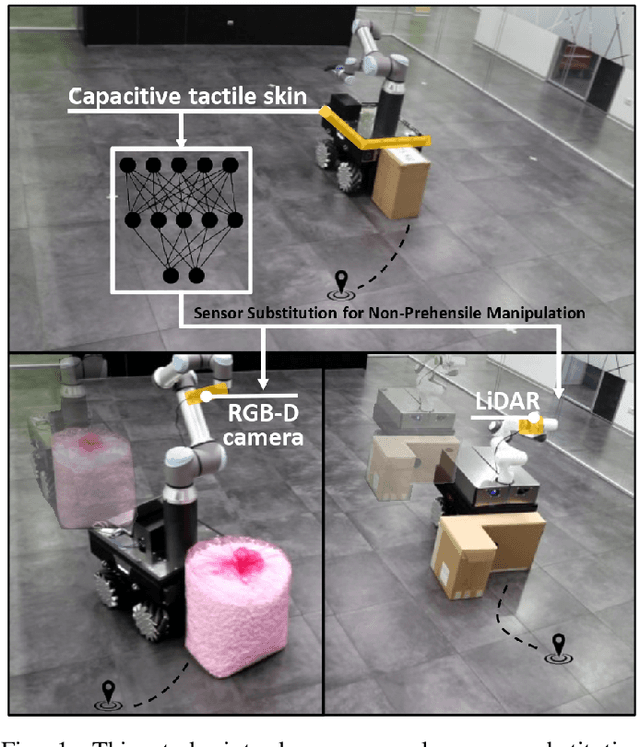
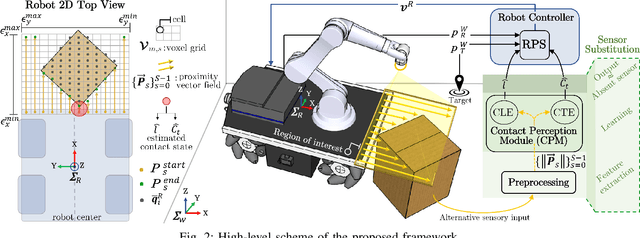
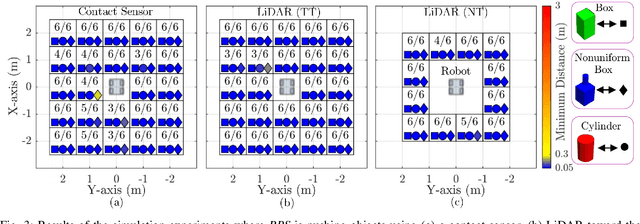
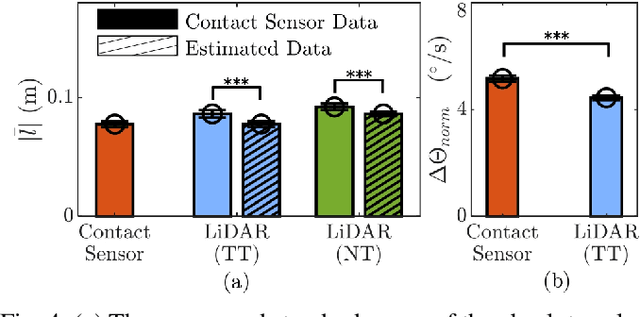
Abstract:Mobile manipulators are increasingly deployed in complex environments, requiring diverse sensors to perceive and interact with their surroundings. However, equipping every robot with every possible sensor is often impractical due to cost and physical constraints. A critical challenge arises when robots with differing sensor capabilities need to collaborate or perform similar tasks. For example, consider a scenario where a mobile manipulator equipped with high-resolution tactile skin is skilled at non-prehensile manipulation tasks like pushing. If this robot needs to be replaced or augmented by a robot lacking such tactile sensing, the learned manipulation policies become inapplicable. This paper addresses the problem of sensor substitution in non-prehensile manipulation. We propose a novel machine learning-based framework that enables a robot with a limited sensor set (e.g., LiDAR or RGB-D camera) to effectively perform tasks previously reliant on a richer sensor suite (e.g., tactile skin). Our approach learns a mapping between the available sensor data and the information provided by the substituted sensor, effectively synthesizing the missing sensory input. Specifically, we demonstrate the efficacy of our framework by training a model to substitute tactile skin data for the task of non-prehensile pushing using a mobile manipulator. We show that a manipulator equipped only with LiDAR or RGB-D can, after training, achieve comparable and sometimes even better pushing performance to a mobile base utilizing direct tactile feedback.
Pushing in the Dark: A Reactive Pushing Strategy for Mobile Robots Using Tactile Feedback
Mar 14, 2024



Abstract:For mobile robots, navigating cluttered or dynamic environments often necessitates non-prehensile manipulation, particularly when faced with objects that are too large, irregular, or fragile to grasp. The unpredictable behavior and varying physical properties of these objects significantly complicate manipulation tasks. To address this challenge, this manuscript proposes a novel Reactive Pushing Strategy. This strategy allows a mobile robot to dynamically adjust its base movements in real-time to achieve successful pushing maneuvers towards a target location. Notably, our strategy adapts the robot motion based on changes in contact location obtained through the tactile sensor covering the base, avoiding dependence on object-related assumptions and its modeled behavior. The effectiveness of the Reactive Pushing Strategy was initially evaluated in the simulation environment, where it significantly outperformed the compared baseline approaches. Following this, we validated the proposed strategy through real-world experiments, demonstrating the robot capability to push objects to the target points located in the entire vicinity of the robot. In both simulation and real-world experiments, the object-specific properties (shape, mass, friction, inertia) were altered along with the changes in target locations to assess the robustness of the proposed method comprehensively.
Robot-Assisted Navigation for Visually Impaired through Adaptive Impedance and Path Planning
Oct 23, 2023



Abstract:This paper presents a framework to navigate visually impaired people through unfamiliar environments by means of a mobile manipulator. The Human-Robot system consists of three key components: a mobile base, a robotic arm, and the human subject who gets guided by the robotic arm via physically coupling their hand with the cobot's end-effector. These components, receiving a goal from the user, traverse a collision-free set of waypoints in a coordinated manner, while avoiding static and dynamic obstacles through an obstacle avoidance unit and a novel human guidance planner. With this aim, we also present a legs tracking algorithm that utilizes 2D LiDAR sensors integrated into the mobile base to monitor the human pose. Additionally, we introduce an adaptive pulling planner responsible for guiding the individual back to the intended path if they veer off course. This is achieved by establishing a target arm end-effector position and dynamically adjusting the impedance parameters in real-time through a impedance tuning unit. To validate the framework we present a set of experiments both in laboratory settings with 12 healthy blindfolded subjects and a proof-of-concept demonstration in a real-world scenario.
Enhancing Human-Robot Collaboration Transportation through Obstacle-Aware Vibrotactile Feedback
Feb 06, 2023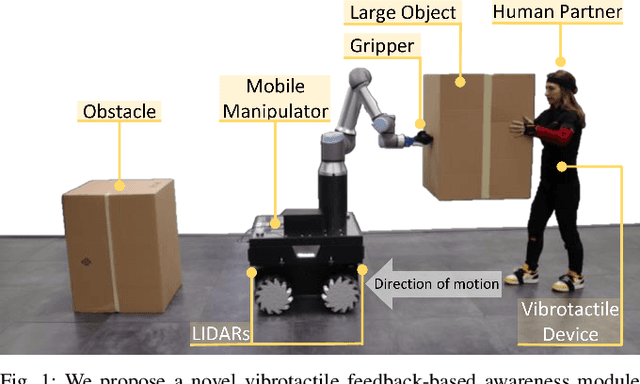
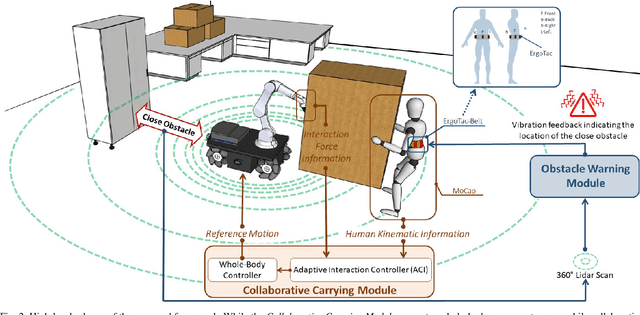
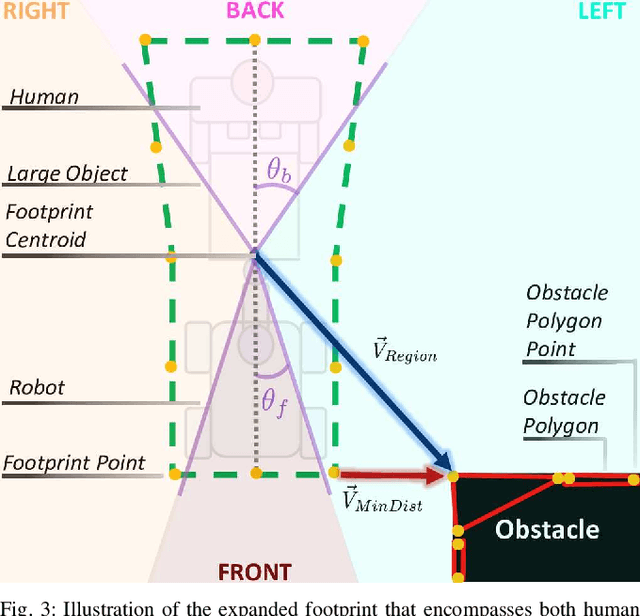
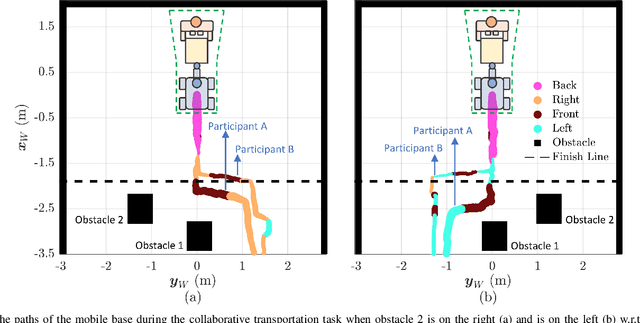
Abstract:Transporting large and heavy objects can benefit from Human-Robot Collaboration (HRC), increasing the contribution of robots to our daily tasks and reducing the risk of injuries to the human operator. This approach usually posits the human collaborator as the leader, while the robot has the follower role. Hence, it is essential for the leader to be aware of the environmental situation. However, when transporting a large object, the operator's situational awareness can be compromised as the object may occlude different parts of the environment. This paper proposes a novel haptic-based environmental awareness module for a collaborative transportation framework that informs the human operator about surrounding obstacles. The robot uses two LIDARs to detect the obstacles in the surroundings. The warning module alerts the operator through a haptic belt with four vibrotactile devices that provide feedback about the location and proximity of the obstacles. By enhancing the operator's awareness of the surroundings, the proposed module improves the safety of the human-robot team in co-carrying scenarios by preventing collisions. Experiments with two non-expert subjects in two different situations are conducted. The results show that the human partner can successfully lead the co-transportation system in an unknown environment with hidden obstacles thanks to the haptic feedback.
Carrying the uncarriable: a deformation-agnostic and human-cooperative framework for unwieldy objects using multiple robots
Sep 28, 2022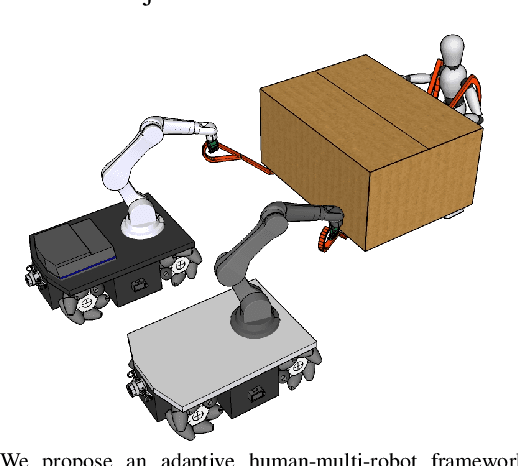
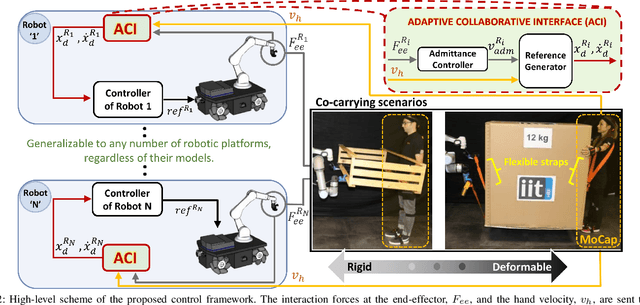

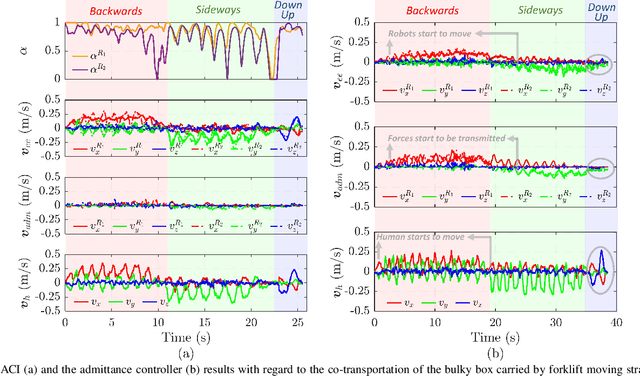
Abstract:This manuscript introduces an object deformability-agnostic framework for co-carrying tasks that are shared between a person and multiple robots. Our approach allows the full control of the co-carrying trajectories by the person while sharing the load with multiple robots depending on the size and the weight of the object. This is achieved by merging the haptic information transferred through the object and the human motion information obtained from a motion capture system. One important advantage of the framework is that no strict internal communication is required between the robots, regardless of the object size and deformation characteristics. We validate the framework with two challenging real-world scenarios: co-transportation of a wooden rigid closet and a bulky box on top of forklift moving straps, with the latter characterizing deformable objects. In order to evaluate the generalizability of the proposed framework, a heterogenous team of two mobile manipulators that consist of an Omni-directional mobile base and a collaborative robotic arm with different DoFs is chosen for the experiments. The qualitative comparison between our controller and the baseline controller (i.e., an admittance controller) during these experiments demonstrated the effectiveness of the proposed framework especially when co-carrying deformable objects. Furthermore, we believe that the performance of our framework during the experiment with the lifting straps offers a promising solution for the co-transportation of bulky and ungraspable objects.
A Shared Autonomy Reconfigurable Control Framework for Telemanipulation of Multi-arm Systems
Jul 20, 2022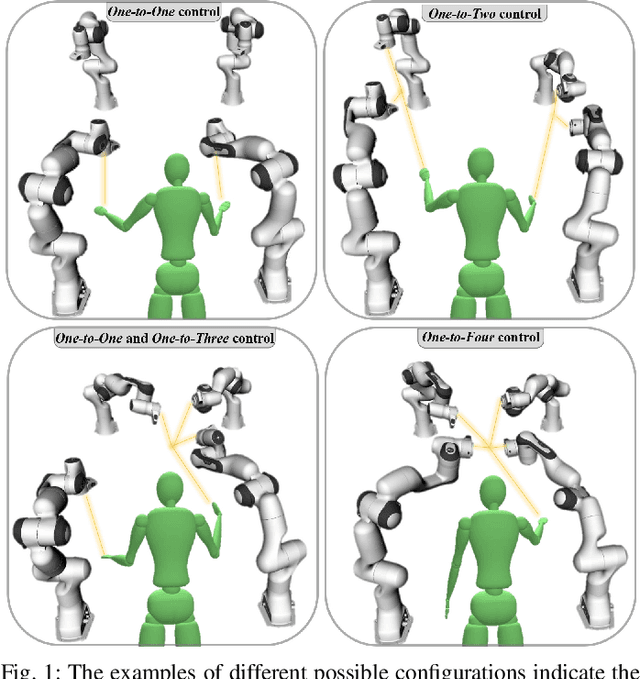
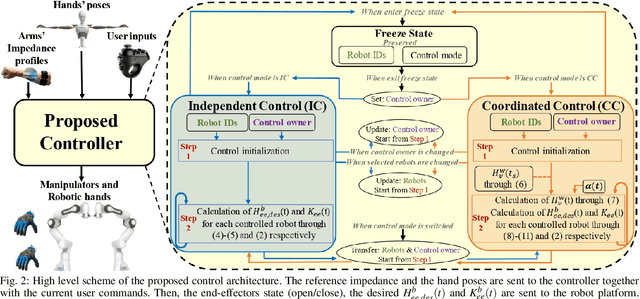
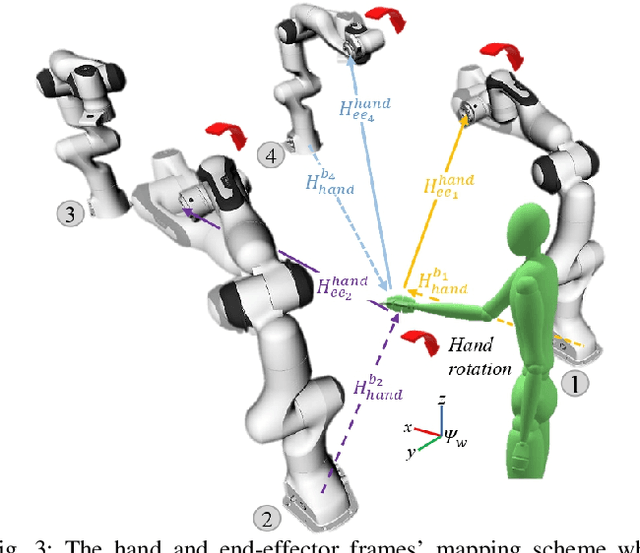
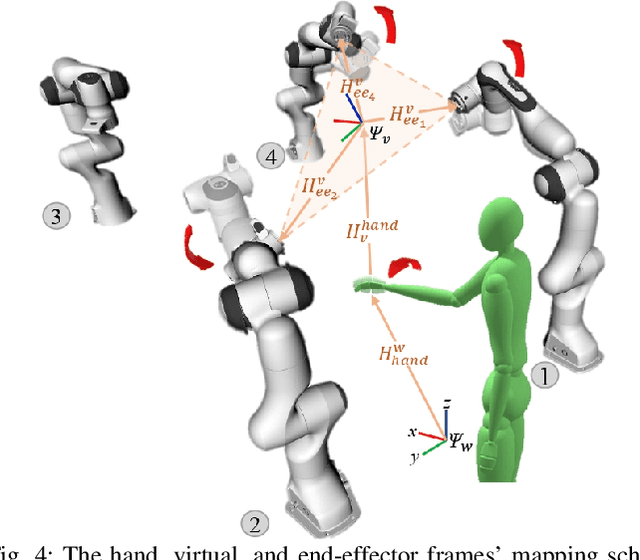
Abstract:Teleoperation is a widely adopted strategy to control robotic manipulators executing complex tasks that require highly dexterous movements and critical high-level intelligence. Classical teleoperation schemes are based on either joystick control, or on more intuitive interfaces which map directly the user arm motions into one robot arm's motions. These approaches have limits when the execution of a given task requires reconfigurable multiple robotic arm systems. Indeed, the simultaneous teleoperation of two or more robot arms could extend the workspace of the manipulation cell, or increase its total payload, or afford other advantages. In different phases of a reconfigurable multi-arm system, each robot could act as an independent arm, or as one of a pair of cooperating arms, or as one of the fingers of a virtual, large robot hand. This manuscript proposes a novel telemanipulation framework that enables both the individual and combined control of any number of robotic arms. Thanks to the designed control architecture, the human operator can intuitively choose the proposed control modalities and the manipulators that make the task convenient to execute through the user interface. Moreover, through the tele-impedance paradigm, the system can address complex tasks that require physical interaction by letting the robot mimic the arm impedance and position references of the human operator. The proposed framework is validated with 8 subjects controlling 4 Franka Emika Panda robots with 7-DoFs to execute a telemanipulation task. Qualitative results of the experiments show us the promising applicability of our framework.
 Add to Chrome
Add to Chrome Add to Firefox
Add to Firefox Add to Edge
Add to Edge